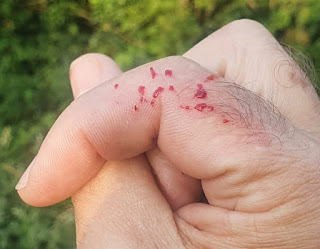Thirty years ago I took a school expedition to a remote, uninhabited island off the north coast of Southerland in Scotland. It's called Eilean nan Ron in Gaelic--or Ron--to us. The main reason for going was to catch Storm Petrels which breed on the island--and with only a couple of breaks, we have visited the island every year since--ringing in excess of 20,000 Storm Petrels over the years!!
Unfortunately I wasn't able to join the team this year, so 13 folk made their way up the 550 miles to eventually meet at the Kyle of Tongue hostel on Thursday 8th July and to be ferried across by the ever reliable local-Jean-on the Friday morning from the tiny harbour at Skerray. Several trips are needed because of the number of people and the amount of kit needed even for just a three night visit:-
It's really helpful when the sea is as calm as this--the boat is only small-but the distance as you can see isn't too far.
Stormies really are the most delightful little birds as you can see from these two pics..
As you can see they are essentially black, with a white rump and to get an idea of their size here's one in the hand
As you can see, they're not much bigger than a sparrow!! There are so many things I could talk about these wonderful little birds --but here's just a few things:-
--they nest in rock crevices, one bird sits on the single egg for a few days while the other feeds miles out to sea
--the returning bird only comes back under cover of darkness to avoid being predated by gulls
--many of the birds we catch are 2-3 year olds which have spent their early years off the coast of South Africa; they are prospecting remote islands looking for mates and nest sites
--over the 30 years we have NEVER seen a Storm Petrel at sea around the island during the day; but from around midnight they pour onto the island in their hundreds
This year the team ringed just short of 700 new birds in three nights!! In addition they caught about 150 already ringed birds, including 2 which were carrying rings from Norwegian ringers. It'll take some time to analyse all these ringed birds but if there are any particularly interesting ones I'll report later.
Ron also has a good population of about 20 pairs of Great Skuas or Bonxies as they are known. These are big, fearless piratical birds who will attack and eat pretty much whatever they like--even birds up to the size of a Gannet. They construct a very simple grass cup for a nest and usually lay two eggs...
One has hatched here and quite cute it looks.....
This phase doesn't last long and it soon turns into a bit of a beast--eventually about 60cm long with a 1.5m wingspan.
The range and number of other species on the small island isn't great because there are few habitats. But some of the old houses ( derelict now) provide nesting sites for several species including Wheatear
Newly fledged Wheatear
And the cliffs provide good nesting sites for the Rock Dove. This is one the team caught this year which we had ringed in 2015!
Just look at those bright red legs on this Rock Dove.
Team members are making their way home as I write, I hope to give you any more stories when I de-breif them later in the week.






























